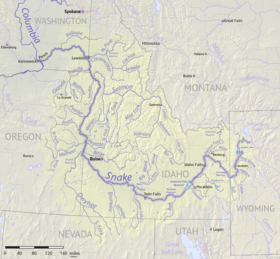The Snake River is a major river in the interior Pacific Northwest region of the United States. About 1,080 miles (1,740 km) long, it is the largest tributary of the Columbia River, which is the largest North American river that empties into the Pacific Ocean. Beginning in Yellowstone National Park, western Wyoming, it flows across the arid Snake River Plain of southern Idaho, the rugged Hells Canyon on the borders of Idaho, Oregon and Washington, and finally the rolling Palouse Hills of southeast Washington. It joins the Columbia River just downstream from the Tri-Cities, Washington, in the southern Columbia Basin.
The river's watershed, which drains parts of six U.S. states, is situated between the Rocky Mountains to the north and east, the Great Basin to the south, and the Blue Mountains and Oregon high desert to the west. The region has a long history of volcanism; millions of years ago, Columbia River basalts covered vast areas of the western Snake River watershed, while the Snake River Plain was a product of the Yellowstone volcanic hotspot. The river was further altered by catastrophic flooding in the most recent Ice Age, which created such features as the Snake River Canyon and Shoshone Falls.
The Snake River once hosted some of the largest North American runs of salmon and other anadromous fish. For thousands of years, salmon fishing has played a central role in the culture and diet of indigenous peoples. The Shoshone and Nez Perce were the largest of several tribes that lived along the river by the turn of the 19th century. In 1805, while searching for a route from the eastern US to the Pacific, Lewis and Clark became the first non-natives to see the river. Fur trappers explored more of the watershed, and drove beaver to near extinction as the Americans and British vied for control of Oregon Territory.
Although travelers on the Oregon Trail initially shunned the dry and rocky Snake River region, a flood of settlers followed gold discoveries in the 1860s, leading to decades of military conflict and the eventual expulsion of tribes to reservations. At the turn of the 20th century, some of the first large irrigation projects in the western US were developed along the Snake River. South-central Idaho earned the nickname "Magic Valley" with the rapid transformation of desert into farmland. Numerous hydroelectric dams were also constructed, and four navigation dams on its lower section created a shipping channel to Lewiston, Idaho – the furthest inland seaport on the West Coast.
While dam construction, commercial fishing and other human activities have greatly reduced anadromous fish populations since the late 19th century, the Snake River watershed is still considered important habitat for these fish. The Snake and its tributary, the Salmon River, host the longest sockeye salmon run in the world, stretching 900 miles (1,400 km) from the Pacific to Redfish Lake, Idaho. Since the 1950s, public agencies, tribal governments and private utilities have invested heavily in fishery restoration and hatchery programs, with limited success. The proposed removal of the four lower Snake River dams for fish passage is a significant ongoing policy debate in the Pacific Northwest.
- ^ a b c "Snake River". Geographic Names Information System. United States Geological Survey, United States Department of the Interior. December 31, 1981. Retrieved January 27, 2024.
- ^ U.S. Geological Survey. "U.S. Geological Survey Topographic Map: Badger Creek, Wyoming quad". TopoQuest. Retrieved January 27, 2024.
- ^ a b c Cite error: The named reference
TNMwas invoked but never defined (see the help page). - ^ "Boundary Descriptions and Names of Regions, Subregions, Accounting Units and Cataloging Units". U.S. Geological Survey. Archived from the original on April 27, 2012. Retrieved August 22, 2010.
- ^ a b c d "Data Query: Ice Harbor Dam and Lake Sacajawea". U.S. Army Corps of Engineers. Retrieved January 31, 2024. Data collected at this station must be downloaded in CSV format.
- ^ "National Wild and Scenic Rivers System". rivers.gov. National Wild and Scenic Rivers System. Retrieved January 5, 2023.


